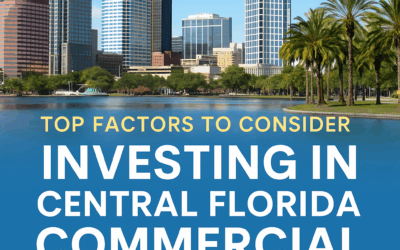Florida’s industrial real estate market has entered a golden age. Warehouses, logistics hubs, cold storage, and distribution centers are being built and leased at a pace the state has rarely seen. The reason is simple: Florida is perfectly positioned as a logistics gateway for the Southeast, the Caribbean, and Latin America, and the e-commerce boom has supercharged demand.
At Steinbauer Real Estate, we believe this industrial surge represents one of the strongest opportunities for commercial real estate investors in 2025 and beyond. Here’s why—and what to watch.
Why Industrial Is Booming in Florida
1. E-commerce Growth
Online shopping isn’t just thriving—it’s reshaping supply chains. Retailers need distribution hubs close to customers to offer same-day or next-day shipping. Florida’s dense population and strategic geography make it ideal.
2. Port Activity & Infrastructure
Major seaports like Miami, Jacksonville, and Tampa are expanding capacity and deepening channels to accommodate larger ships. Improved rail and highway systems are reducing delivery times statewide.
3. Population Migration & Consumption Growth
Florida gains over 1,000 residents per day. More people means more goods moving through the state—and more demand for storage, fulfillment, and logistics services.
4. Favorable Tax & Business Climate
No state income tax and pro-business policies keep attracting logistics operators and manufacturers.
Industrial Hotspots in Florida
- Jacksonville – Home to JAXPORT and a growing inland logistics hub, this market offers lower costs and strong connectivity.
- Tampa Bay – Centrally located with access to I-4 corridor; a magnet for regional distribution centers.
- Miami – A high-demand, high-cost market where space is scarce but strategic for imports from Latin America.
- Orlando – A rapidly growing inland market ideal for last-mile delivery and e-commerce fulfillment.
- Lakeland / Polk County – Fast-growing logistics corridor with abundant land and excellent highway access.
What Tenants Are Looking For
Industrial users today want more than just big empty boxes. Desired features include:
- 36–40 ft clear ceiling heights for high racking systems.
- Cross-dock and rear-load configurations for efficient truck flow.
- Ample trailer parking and yard space.
- Modern energy systems and sustainable design.
- Cold storage capabilities (especially for food logistics).
Owners who can deliver these features command premium rents.
Investment Advantages of Industrial Assets
- Long-Term Tenant Stability: Industrial tenants often sign 5–10+ year leases.
- Strong Rent Growth: Florida has seen double-digit rent growth in prime markets.
- Lower Management Burden: Industrial properties are simpler to maintain than retail or multifamily.
- Institutional Demand: REITs and private equity funds are aggressively buying industrial assets, boosting valuations.
Potential Risks to Monitor
- Rising Construction Costs: Building new warehouse space is getting more expensive.
- Interest Rate Sensitivity: Higher borrowing costs can affect valuations.
- Supply Surges: In some markets, heavy new construction could temporarily outpace demand.
- Insurance Costs: Particularly for properties in coastal or hurricane-prone zones.
A careful site selection strategy—evaluating absorption rates, transportation access, and tenant demand—is essential.
The Road Ahead
Florida’s industrial market is poised for sustained strength as e-commerce, trade, and population growth converge. Even as some sectors of commercial real estate struggle with vacancy and rent pressure, industrial assets continue to post record-low vacancies and rising rents.
At Steinbauer Real Estate, we help investors, developers, and owner-operators seize this opportunity—identifying prime sites, structuring deals, and navigating local zoning and permitting. With the right strategy, industrial real estate can be one of the most resilient and profitable segments of your portfolio.




